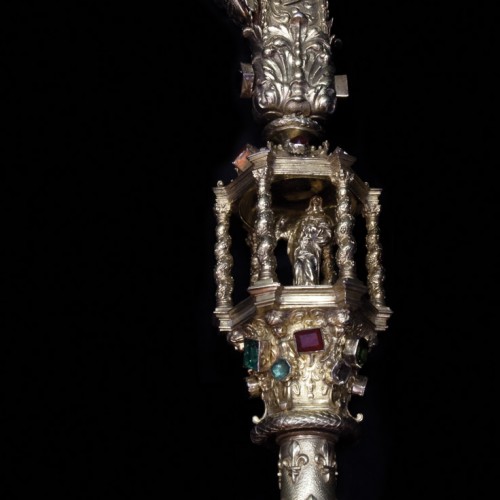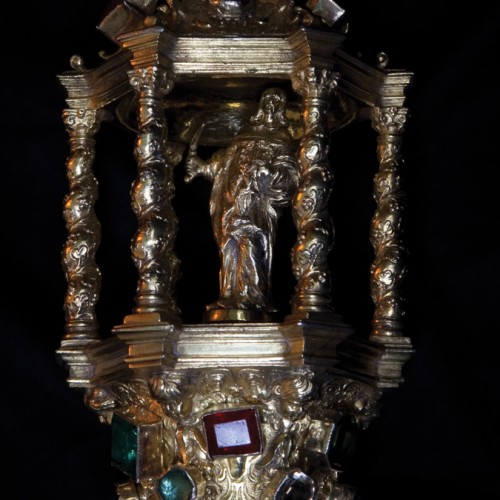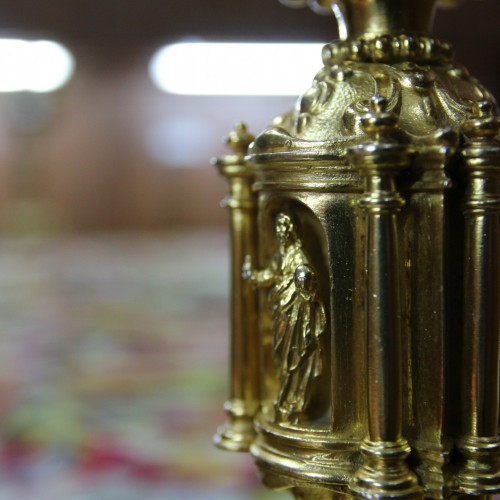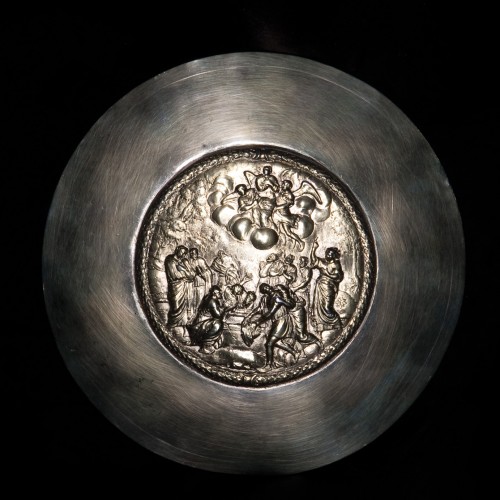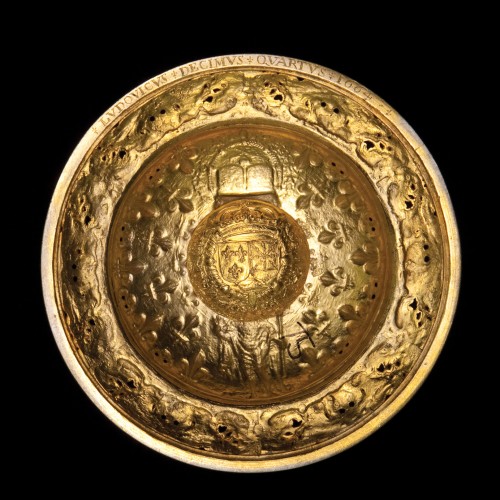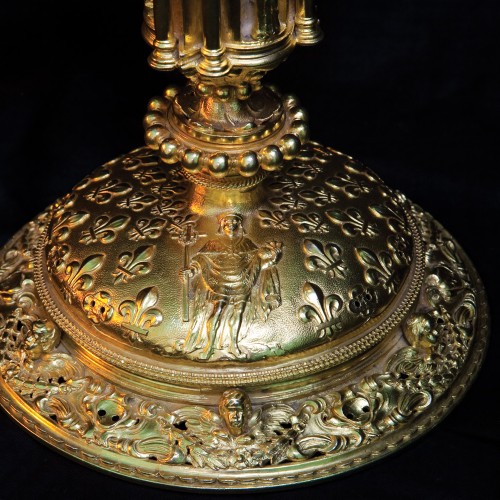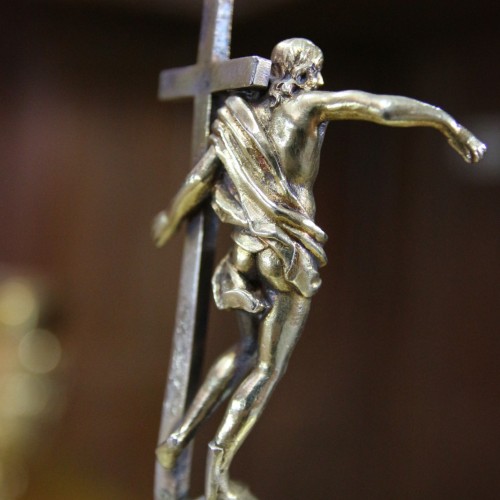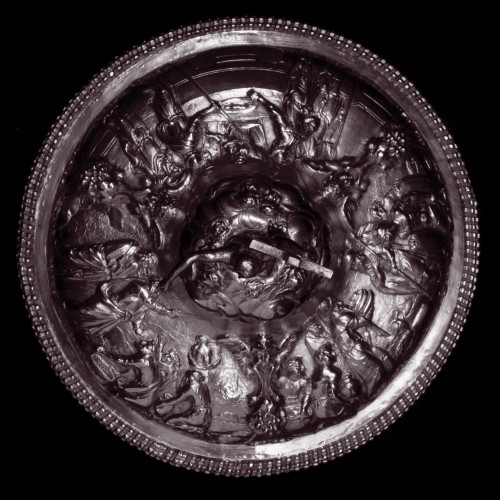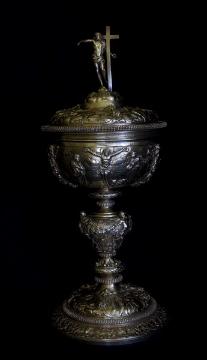The gifts of Louis XIV offered to the Church of the Holy Sepulchre in Jerusalem
One of the most astonishing collections of French religious orfèverie, offered by Louis XIV to the Holy Land, has been preserved by the Franciscan Custody of Jerusalem since the 17th century. The most beautiful pieces will be displayed in the future room of the Terra Sancta Museum dedicated to French gifts. Michèle Bimbenet-Privat, general curator of the Objets d’Art Department at the Louvre and a member of International Scientific Committee, tells us the story of this extraordinary acquisition.
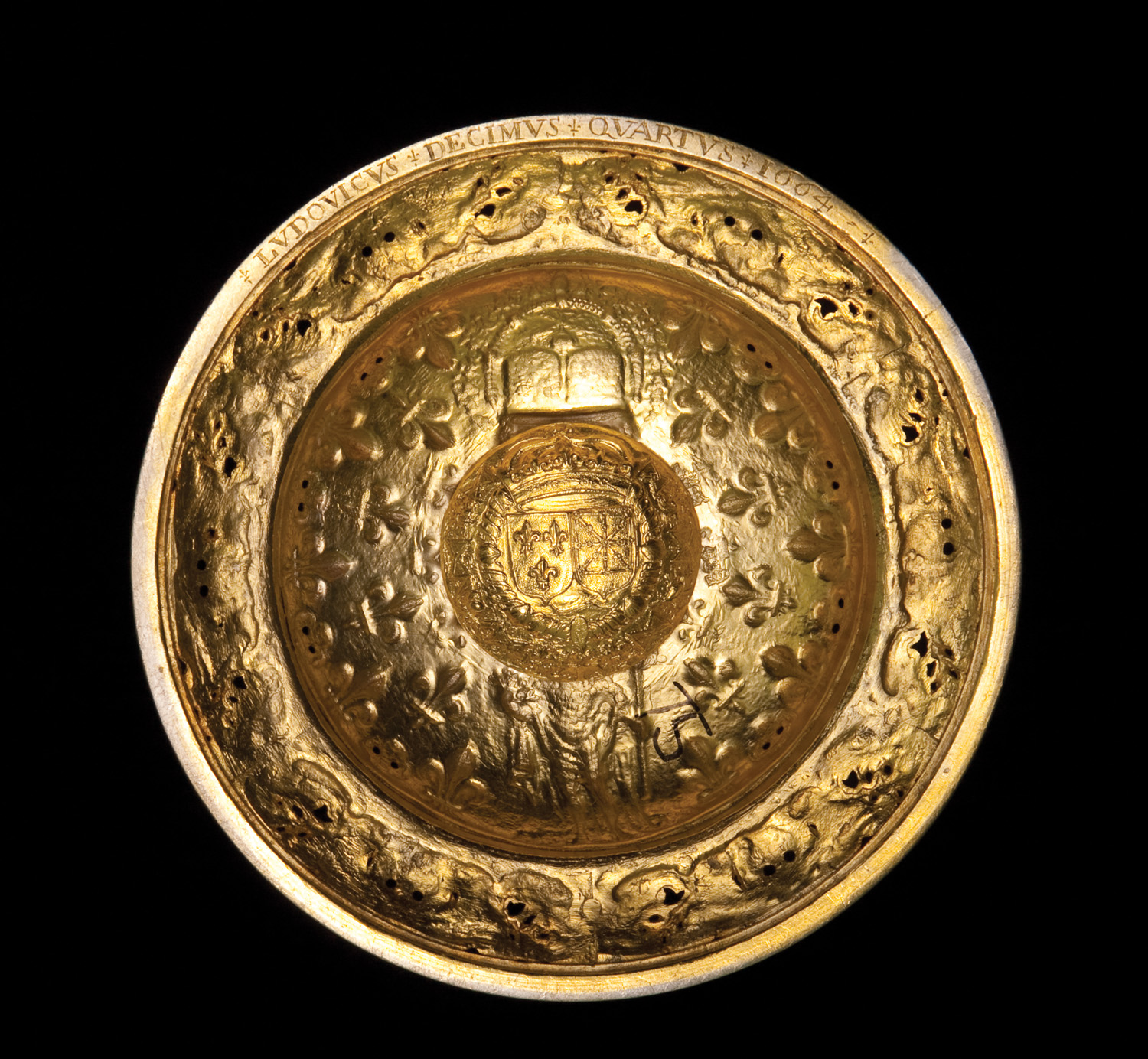
[FR]Vue du dessous du calice en argent doré offert par Louis XIV réalisé par Nicolas Dolin[/FR][EN]View of the bottom of the gilded silver chalice offered by Louis XIV made by Nicolas Dolin[/EN]
We know that French orfèverie was regularly destroyed throughout the Ancient Regime by sovereigns who tried to supply the mints in order to finance their military campaigns. In this regard, Louis XIV was without a doubt much more destructive than the French Revolution was to be: his principal ordinances of fonts, issued in 1689 and 1709, reduced to nothing not only the orfèverie of his loyal subjects, but also all these surrounding precious metals which made his glory, from the silver furniture of his palaces to the golden dishes of his table.
In the absence of large numbers of works, it is difficult to reconstruct the orfèverie of royal chapels, even if the scrupulously managed archives at the Garde-Meuble provide some fairly precise descriptions. However, throughout the reign of Louis XIV, many sets of liturgical objects were commissioned for the service of the king and the queen, both at Versailles and other royal residences, and each of the princes of the royal family also received their own sets.
Winning the graces of the Custos of the Holy Land
It is within this context that we should consider one of the most amazing collections of French religious orfèverie still linked with the name of Louis XIV: the vermeil liturgical objects offered by the king of France to Saint-Sépulcre, still found there, carefully preserved by the Franciscans of the Custody of the Holy Land. The kings of France were not the only European princes to grace the Holy Sepulchre with gifts, but their generosity was particularly evident during the 17th century. Since 1516, the year of the Ottoman seizure of the Holy Places, French sovereigns have made the protection of Christian interests in Palestine one of the stated conditions of the Franco-Ottoman alliance. This oriental policy, initiated by François I during the time of Suleiman the Magnificent, unique to France and fiercely criticized by European neighbors, had the advantage of reconciling the political and economic interests of the “very Christian King.” The policy was not devoid of ulterior motives, seen in a certain will to establish a protectorate in the Holy Places, which resulted, under Louis XIII, in the short-lived installation of a French consul in Jerusalem. It is therefore not surprising to see Louis XIV take over the policy of his predecessors and attempt, with splendid gifts, to gain the favor of the Custos of the Holy Land.
The first gift, dated by its hallmarks to 1654, was thus intended for the Custos: it consists of an impressive gilded silver crosier set with table-cut or cabochon precious stones, with a shaft decorated with fleurs-de-lis, nearly two meters long. Its knop takes the form of a tempietto flanked by Solomonic columns and covered with a dome, in the center of which is an effigy of Saint Louis holding his scepter in his right hand and, in his left hand, the crown of thorns and the nails of the Passion. We do not know how this sumptuous gift was received, but the generosity of the king most likely failed to have a memorable effect, for ten years later, in 1664, the king renewed his gesture shortly after the election of a new Custos. This time, the gift was a magnificent gilded silver chalice with the inscription “LUDOVICUS. DECIMUS. QUARTUS. 1664” engraved at the base of the royal coat of arms of France and Navarre and the figure of St Louis. The knop is decorated with effigies of Christ, St Anthony of Padua and St Francis set in niches, while the false cup is chiseled with scenes of the Flagellation, the Crucifixion, and the Resurrection. The chalice still bears traces of sites where precious stones, like the crosier of 1654, were once inserted. A gilded silver paten, chiseled with a scene of the Assumption, accompanies the chalice, perhaps like other objects which are now lost.
The Parisian goldsmith Nicolas Dolin
Characterized by a precise and vigorous carving style, the three objects preserved at Saint-Sépulcre are signed with the stamp of the Parisian goldsmith Nicolas Dolin. This great goldsmith, whose workshop was active from 1648 to 1684, was famous for the excellent quality of his religious orfèverie, for example the works in the treasury of the Cathedral of Troyes which he created between 1665 and 1667 for the Château of Villacerf, one of the few complete sets still preserved in France. The chalice is chiseled with episodes from the life of the Virgin, and the paten with a scene of the Pentecost, where the presence of Mary, personification of the Church, confirms the Marian theme of the set offered to the bishop. The other known works of Nicolas Dolin, all ecclesiastical, prove how well the goldsmith was able to interpret with equal talent scenes from the Gospels inspired by works of piety and ornamental motifs from a secular repertoire discretely adapted to meet liturgical needs. However, as unique gifts explicitly offered by Louis XIV to the Custody of Jerusalem, the works of Nicolas Dolin are not the only French liturgical objects still preserved at Saint-Sépulcre.
From the reign of Louis XIV, there is another beautiful gilded silver chalice accompanied by a paten whose donor remains anonymous. Created by a Parisian goldsmith around 1659-1660, this chalice is entirely engraved with scenes from the childhood of Jesus, arranged on flowery scrolls separated by the heads of angels. Based on its iconography, the chalice was most likely destined for the Church of the Nativity in Bethlehem. Among the other French artifacts still preserved in the treasury of the Holy Sepulchre, let us finally mention a splendid gilded silver ciborium which was made in Paris by the goldsmith Jean Hubé in 1668. Crowned with a resurrected Christ in the round carried by clouds, the ciborium is completely engraved with biblical episodes related to the Eucharist or illustrations of the Passion. We know that French goldsmiths studied Lyonnais Renaissance illustrated bibles for inspiration in depicting these scenes with their charming vitality and elegance, earning their reputation as master sculptors: the works in the treasury of the Holy Sepulchre show their talent in modeling the body, with great variety in figures, faces and postures, and, based on the subtle contrasts between polished and matte surfaces, their skill in playing magnificently with the light.
No doubt this is only a brief glimpse at the rich works of art arising from the intense piety of pilgrims and European sovereigns which have for centuries endowed the sanctuaries of the Holy Places. But in the case of French orfèverie, the gifts of Louis XIV evoke lost Palatine chapels, and in addition to serving the king’s political agenda, they enable us to better understand the liturgical goldsmith’s important role during the Catholic Reformation, whose work, inspired by biblical texts, was meant to educate just as much as it was meant to nourish the faith of the faithful.
Extract of the article written for the Terre Sainte Magazine issue of March-April 2011, on the occasion of an exhibition at the Château of Versailles titled “Une Chapelle pour le Roi” to celebrate the 300th anniversary of the chapel.

